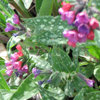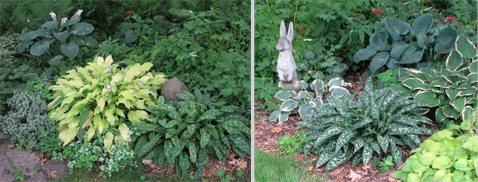Add some sparkle to your shade or woodland garden with pulmonaria (Boraginaceae). Also widely known by the less-than-appealing common name of lungwort, and by the names Bethlehem sage and cowslip, these perennials are most often recognized by their white- or silver-speckled leaves. The dots and/or splotches can be fairly crisp or can appear to bleed into the leaf. Some of the more than a dozen pulmonaria species don’t have spots. Some have hairy leaves, while others have smooth leaves. Leaf size, color and markings change through the year, too, making them fun to watch grow.
 Pulmonaria are flowering while some spring ephermerals are still blooming, which helps give the bed interest until the hostas have opened up. Pulmonaria blossoms can be white, or shades of blue, violet, or pink. They can also have blossoms of more than one color on the same plant, such as the Excalibur flowers seen in the photo inset on the left.
Pulmonaria are flowering while some spring ephermerals are still blooming, which helps give the bed interest until the hostas have opened up. Pulmonaria blossoms can be white, or shades of blue, violet, or pink. They can also have blossoms of more than one color on the same plant, such as the Excalibur flowers seen in the photo inset on the left.At the Front of the Border, too
Pulmonarias also make great specimens. In the picture on the left, below, a P. longifolia is paired with the hosta Pineapple Upside-down Cake. They play well off each other having a similar leave shape and habit, but contrasting color and texture. In the right photo, a Raspberry Splash makes a nice specimen. Its leave shape is contrasts sharply with those of the hostas around it.
Pulmonarias are quite reliable in Zones 4 to 7, with some rated for Zone 8, and are fully evergreen in the more moderate climes. They do well in relatively moist, fertile soil, and shady conditions. High heat and humidity can lead to a bout of powdery mildew from which they will usually bounce back once drier air returns. They are easy to divide and move in the spring or fall. Another advantage of these plants slow-growing groundcovers is they will fill in any space where they can find room and light, so like the hostas they do a good job of smothering weeds, reducing maintenance.
To maintain vitality, pulmonaria should be divided about every three to five years. They are not invasive, but if you don’t cut off their flower heads, you may find one or two pop up somewhere in your yard.

